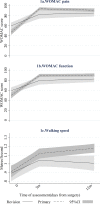Pain and Function Recovery Trajectories following Revision Hip Arthroplasty: Short-Term Changes and Comparison with Primary Hip Arthroplasty in the ADAPT Cohort Study
- PMID: 27741321
- PMCID: PMC5065160
- DOI: 10.1371/journal.pone.0164839
Pain and Function Recovery Trajectories following Revision Hip Arthroplasty: Short-Term Changes and Comparison with Primary Hip Arthroplasty in the ADAPT Cohort Study
Abstract
Background and purpose: Patients report similar or better pain and function before revision hip arthroplasty than before primary arthroplasty but worse results are reported after revision surgery than after primary surgery. The trajectory of post-operative recovery during the first months and any differences by type of surgery have received little attention. We explored the trajectories of change in pain and function after revision hip arthroplasty to 12-months post-operatively and compare them with those observed after primary hip arthroplasty.
Methods: This study is a prospective cohort study of patients undergoing primary (n = 80 with 92% for an indication of osteoarthritis) and revision (n = 43) hip arthroplasties. WOMAC pain and function scores and walking speed were collected pre-operatively, at 3 and 12-months post-operatively. Multilevel regression models were used to chart and compare the trajectories of change (0-3 months and 3-12 months) between types of surgery.
Results: The improvements in pain and function following revision arthroplasty occurred within the first 3-months with no evidence of further change beyond this initial period. While the pattern of recovery was similar to the one observed after primary arthroplasty, improvements in the first 3-months were smaller after revision compared to primary arthroplasty. Patients listed for revision surgery reported lower pre-operative pain levels but similar post-operative levels compared to those undergoing primary surgery. At 12-months post-operation patients who underwent a revision arthroplasty had not reached the same level of function achieved by those who underwent primary arthroplasty.
Conclusion: The post-operative improvements in pain and function are larger following primary hip arthroplasty than following revision hip arthroplasty. Irrespectively of surgery type, most of the improvements occur in the first three post-operative months. More research is required to identify whether the recovery following revision surgery could be improved with specific post-operative interventions.
Conflict of interest statement
The authors have declared that no competing interests exist.
Figures


References
-
- National Joint Registry for England and Wales. 11th Annual Report 2014. Available from: http://www.njrreports.org.uk/Portals/0/PDFdownloads/NJR%2011th%20Annual%....
-
- National Joint Registry. 2015 [29/02/2016]. Available from: http://www.njrreports.org.uk/hips-all-procedures-activity/H01v2NJR?repor....
-
- Espehaug B, Havelin LI, Engesaeter LB, Langeland N, Vollset SE. Patient satisfaction and function after primary and revision total hip replacement. Clin Orthop Relat Res. 1998;(351):135–48. . - PubMed
MeSH terms
Grants and funding
LinkOut - more resources
Full Text Sources
Other Literature Sources
Medical

